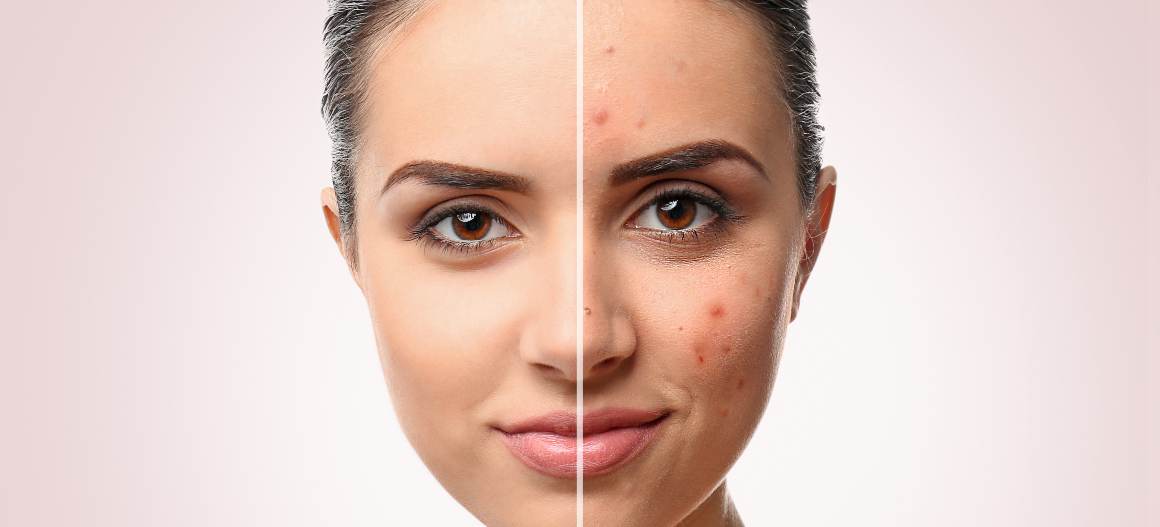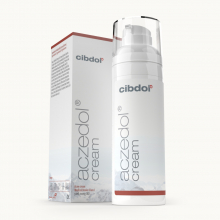What are the 4 Grades of Acne?
Published:
Acne is a common skin condition that affects people of all ages. It occurs when hair follicles become clogged with oil and dead skin cells, leading to whiteheads, blackheads, pimples, and cysts. Acne can range from mild to severe, and dermatologists classify it into different grades based on the type and amount of lesions. Understanding the four grades of acne can help determine the best treatment options.
Contents:
- Grade 1 Acne
- Grade 2 Acne
- Grade 3 Acne
- Grade 4 Acne
- Determining Your Acne Grade
- Acne Grades and Scar Risk
- When to See a Dermatologist
- The Takeaway
- Frequently Asked Questions on the Grades of Acne
- What are the 4 grades of acne?
- What are comedones?
- What are papules and pustules?
- What are nodules and cysts?
- How can you determine your specific acne grade?
- How does acne grade correlate with scar risk?
- When should you see a dermatologist?
- What is the treatment for different acne grades?

Grade 1 Acne
Grade 1 or mild acne consists of occasional whiteheads, blackheads, and small pimples. Grade 1 acne causes minimal inflammation and typically occurs as a result of hormonal changes, such as during puberty.
The primary lesions in grade 1 acne are:
- Comedones - better known as whiteheads and blackheads. Comedones develop when dead skin cells and oil clog the pore opening. Whiteheads are closed comedones where the clog stays below the skin surface. Blackheads are open comedones that appear as dark bumps.
- Papules - small, pink or red bumps that are tender to the touch. Papules form when the walls surrounding the clogged pore break down and become inflamed.
Grade 1 acne is generally easy to treat with over-the-counter cleansers, creams, and gels. Consistent cleansing and products containing benzoyl peroxide or salicylic acid help remove excess oil and dead skin cells. Grade 1 acne usually responds quickly to topical over-the-counter treatments.
Grade 2 Acne
Grade 2 or moderate acne consists of more significant papules and pustules. Pustules are similar to papules but have visible pus at the tips. Moderate inflammatory acne is common in teenagers and young adults.
The primary lesions in grade 2 acne are:
- Papules - these small, pink pimples signify moderately inflamed pores.
- Pustules - these are papules with visible pus at the tips. The pus consists of dead skin cells, bacteria, and sebum.
- Comedones - clogged pores in the form of blackheads and whiteheads also occur alongside inflammatory papules and pustules.
People with grade 2 acne typically have between 20-100 lesions. The papules and pustules can be widespread or concentrated in one area. Moderate acne often flares up periodically before the menstrual cycle due to hormonal changes.
OTC topical treatments can help manage grade 2 acne. However, many people require prescription medications like retinoids, benzoyl peroxide, or antibiotic gels and creams. Oral antibiotics may be prescribed for short-term use.
With proper treatment, grade 2 acne can be cleared up without leading to permanent scarring. Paying close attention to skin care can help control and reduce breakouts.
Grade 3 Acne
Grade 3 acne is classified as severe papulopustular acne. It consists of many inflammatory papules and pustules that cover large areas of the face, chest, and back. Grade 3 acne is often painful and unsightly but does not cause nodular or cystic lesions.
Here are the primary lesions seen in grade 3 acne:
- Numerous papules and pustules - Grade 3 acne consists of widespread inflammation. There can be over 100 small, red pimples over the face, neck, chest, shoulders, and back.
- Occasional nodules - Unlike grade 4 acne, grade 3 acne does not have a significant number of nodules. A few deep, painful nodules may occasionally occur.
- Comedones - Both open and closed comedones are generally present amongst the inflammatory lesions.
People with severe papulopustular acne often have painful, tender skin. The large number of pimples can lead to scarring if the acne is left untreated.
Severe acne requires prescription oral and topical medications to control inflammation and kill acne-causing bacteria. Isotretinoin may be prescribed for resistant severe inflammatory acne. Proper skin care and avoiding triggers like stress and greasy cosmetics also helps manage breakouts.
Grade 4 Acne
Grade 4 acne consists of widespread inflammatory papules, pustules, nodules, and cysts. It is classified as severe nodular or cystic acne. Nodules and cysts can cause severe scarring if not treated properly.
Here are the main lesions that characterize grade 4, severe nodulocystic acne:
- Papules and pustules - Moderate to severe inflammatory pimples are present.
- Nodules - Hard, painful bumps form deep within the skin and are a sign of severe inflammation. Nodules develop when clogged pores rupture very deep in the dermis layer of skin.
- Cysts - Cysts are similar to nodules but are larger, more painful, and filled will pus. Cystic blemishes typically need to be treated with injections to drain the pus.
Acne nodules and cysts can lead to extensive scarring and hyperpigmentation. Severe, cystic acne requires urgent medical treatment to avoid permanent skin damage and negative psychological effects like anxiety, depression and reduced self-esteem.
Severe cystic acne requires prescription oral and topical medications. Severe cases may be treated with isotretinoin (high-dose vitamin A). Other treatment options include steroid injections, laser/light therapy, chemical peels, and microdermabrasion to improve scarring.
Determining Your Acne Grade
Knowing the type and amount of lesions you have is necessary for determining the acne grade and appropriate treatment. Here are some things to look out for when assessing your acne:
- Non-inflammatory lesions - These include open and closed comedones (blackheads and whiteheads). Take note of the number of clogged pores.
- Mild inflammatory lesions - Look for small, pink bumps known as papules.
- Moderate inflammatory lesions - Check for pus-filled pimples called pustules.
- Severe inflammatory lesions - Firm, painful nodules and fluid-filled cysts indicate more severe acne.
- Distribution - Note if you just have a few scattered lesions or widespread clusters covering large areas.
- Previous scarring - This can indicate you’ve had severe acne in the past.
- Frequency of flare-ups - Note if you have occasional breakouts versus persistent acne.
Keeping track of your breakouts for a few months helps determine if you have persistent or intermittent acne. Seeing a dermatologist helps properly diagnose your acne grade and recommend suitable therapies.
Acne Grades and Scar Risk
The grade of acne you have often correlates with the risk of permanent acne scarring. Here’s the scar risk for each acne grade:
- Grade 1 - Minimal risk of scarring. Mild comedonal acne and occasional papules typically resolve without leaving scars.
- Grade 2 - Low risk of scarring. Moderate inflammatory acne can lead to some shallow ice pick or boxcar scars.
- Grade 3 - Moderate risk of scarring. Widespread lesions increase chances of scarring. Pitted and depressions scars may occur.
- Grade 4 - High risk of scarring. Nodules and cysts can destroy collagen leading to severe scars.
The more inflamed and long-lasting acne is, the higher the likelihood of scars developing. Prompt treatment is key to preventing permanent damage to the skin.
When to See a Dermatologist
It’s recommend to see a dermatologist if:
- Over-the-counter products haven’t improved acne after 3 months
- Acne is leaving dark spots or scars
- Acne is causing significant emotional distress
- Signs of severe inflammatory acne are present
A dermatologist can properly diagnose your acne grade, identify any underlying causes, and create a tailored treatment plan. For moderate to severe acne, prescription oral and topical medications are often needed to treat inflammation and prevent scarring. A dermatologist may also recommend laser treatments to improve scarring.
The Takeaway
Identifying your specific acne grade is key for finding the right treatment. Mild non-inflammatory acne can be managed with over-the-counter products. However, moderate to severe inflammatory acne requires seeing a dermatologist for professional treatment. The earlier proper acne treatment is started, the lower the risk of lasting physical and emotional scars. Being aware of the four acne grades allows for better understanding of treatment options and potential complications.
Frequently Asked Questions on the Grades of Acne
Acne is a common skin condition that occurs when hair follicles become clogged with dead skin cells and oil. The severity of acne can range from mild to severe. Dermatologists classify acne into 4 grades based on the type and amount of lesions present. Below are answers to some frequently asked questions on understanding and determining the different grades of acne.
What are the 4 grades of acne?
The 4 grades of acne are:
Grade 1 (Mild) – This consists of a few scattered comedones (blackheads and whiteheads) and small inflammatory papules.
Grade 2 (Moderate) - This consists of more pronounced papules and pustules covering larger areas.
Grade 3 (Severe) - This consists of numerous widespread papules, pustules, and occasional nodules.
Grade 4 (Severe Nodular/Cystic) - This is characterized by severe inflammatory nodules and cysts alongside pustules and papules.
What are comedones?
Comedones are clogged hair follicles. There are two types of comedones:
- Whiteheads (closed comedones) - These appear as small, flesh-colored bumps under the skin's surface.
- Blackheads (open comedones) - These look like dark dots on the skin and occur when dead skin cells and oil get trapped in the pore and oxidize, turning black.
What are papules and pustules?
Papules are small red, inflamed bumps without pus. They form when clogged pores get infected and swell up.
Pustules are similar to papules but are filled with visible pus. The pus is comprised of oil, bacteria, and dead skin cells.
What are nodules and cysts?
Nodules are large, hard lumps under the skin caused by deep infection and inflammation of clogged pores. Cysts are similar to nodules but are pus-filled and can be tender and painful. Both indicate severe acne.
How can you determine your specific acne grade?
To determine your acne grade:
- Note the types of blemishes - whether you have mostly comedones, papules, pustules, nodules or cysts.
- Look at the distribution - if you have just a few lesions or clusters covering large areas.
- Check for any scarring, which indicates more severe past acne.
- Keep track of breakout frequency - if they are intermittent or persistent.
- Seeing a dermatologist can help properly diagnose your grade.
How does acne grade correlate with scar risk?
- Grade 1 has minimal scarring risk.
- Grade 2 has a low risk of mild scarring.
- Grade 3 has a moderate risk of scarring.
- Grade 4 has a high risk of severe scarring due to nodules and cysts.
When should you see a dermatologist?
See a dermatologist if:
- Over-the-counter products don’t improve acne after 3 months.
- Acne is leaving scars or dark marks.
- Acne is causing emotional distress.
- Signs of severe acne are present - nodules, cysts, widespread inflammation.
What is the treatment for different acne grades?
- Grade 1 can often be managed with over-the-counter cleansers, creams and gels.
- Grade 2 usually requires prescription topical or oral antibiotics.
- Grade 3 requires prescription oral and topical medicines to control inflammation.
- Severe Grade 4 cystic acne requires urgent, aggressive treatment with oral and topical prescriptions and sometimes procedures like injections or laser therapy.
Seeing a dermatologist helps diagnose your grade and create a customized treatment plan. The earlier proper treatment is started, the lower the acne and scarring risks.















